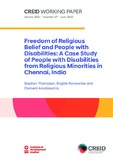| dc.contributor.author | Thompson, Stephen | |
| dc.contributor.author | Rohwerder, Brigitte | |
| dc.contributor.author | Arockiasamy, Clement | |
| dc.coverage.spatial | India | en |
| dc.date.accessioned | 2021-06-22T14:46:28Z | |
| dc.date.available | 2021-06-22T14:46:28Z | |
| dc.date.issued | 2021-06 | |
| dc.identifier.citation | Thompson, S.; Rohwerder, B. and Arockiasamy, C.(2021) Freedom of Religious Belief and People with Disabilities: A Case Study of People with Disabilities from Religious Minorities in Chennai, India, CREID Working Paper 7, Coalition for Religious Equality and Inclusive Development, Brighton: Institute of Development Studies, DOI: 10.19088/CREID.2021.003 | en |
| dc.identifier.isbn | 978-1-78118-782-1 | |
| dc.identifier.uri | https://opendocs.ids.ac.uk/opendocs/handle/20.500.12413/16709 | |
| dc.description.abstract | India has a unique and complex religious history, with faith and spirituality playing an important role in everyday life. Hinduism is the majority religion, and there are many minority religions. India also has a complicated class system and entrenched gender structures. Disability is another important identity. Many of these factors determine people’s experiences of social inclusion or exclusion. This paper explores how these intersecting identities influence the experience of inequality and marginalisation, with a particular focus on people with disabilities from minority religious backgrounds. A participatory qualitative methodology was employed in Chennai, to gather case studies that describe in-depth experiences of participants.
Our findings show that many factors that make up a person’s identity intersect in India and impact how someone is included or excluded by society, with religious minority affiliation, caste, disability status, and gender all having the potential to add layers of marginalisation. These various identity factors, and how individuals and society react to them, impact on how people experience their social existence. Identity factors that form the basis for discrimination can be either visible or invisible, and discrimination may be explicit or implicit.
Despite various legal and human rights frameworks at the national and international level that aim to prevent marginalisation, discrimination based on these factors is still prevalent in India. While some tokenistic interventions and schemes are in place to overcome marginalisation, such initiatives often only focus on one factor of identity, rather than considering intersecting factors. People with disabilities continue to experience exclusion in all aspects of their lives. Discrimination can exist both between, as well as within, religious communities, and is particularly prevalent in formal environments. Caste-based exclusion continues to be a major problem in India. The current socioeconomic environment and political climate can be seen to perpetuate marginalisation based on these factors. However, when people are included in society, regardless of belonging to a religious minority, having a disability, or being a certain caste, the impact on their life can be very positive. | en |
| dc.description.sponsorship | Foreign Commonwealth and Development Office (FCDO) | en |
| dc.language.iso | en | en |
| dc.publisher | Institute of Development Studies | en |
| dc.relation.ispartofseries | CREID Working Paper;7 | |
| dc.rights.uri | http://creativecommons.org/licenses/by/4.0/ | en |
| dc.subject | Participation | en |
| dc.subject | Politics and Power | en |
| dc.subject | Poverty | en |
| dc.subject | Rights | en |
| dc.title | Freedom of Religious Belief and People with Disabilities: A Case Study of People with Disabilities from Religious Minorities in Chennai, India | en |
| dc.type | Series paper (IDS) | en |
| dc.rights.holder | Institute of Development Studies | en |
| dc.identifier.team | Power and Popular Politics | en |
| dc.identifier.doi | 10.19088/CREID.2021.003 | |
| rioxxterms.funder | Department for International Development, UK Government | en |
| rioxxterms.identifier.project | Coalition for Religious Equality and Inclusive Development (CREID) | en |
| rioxxterms.version | VoR | en |
| rioxxterms.versionofrecord | 10.19088/CREID.2021.003 | en |
| rioxxterms.funder.project | 7a473ec6-92f8-49ff-98df-9ec27d8d5fe6 | en |


